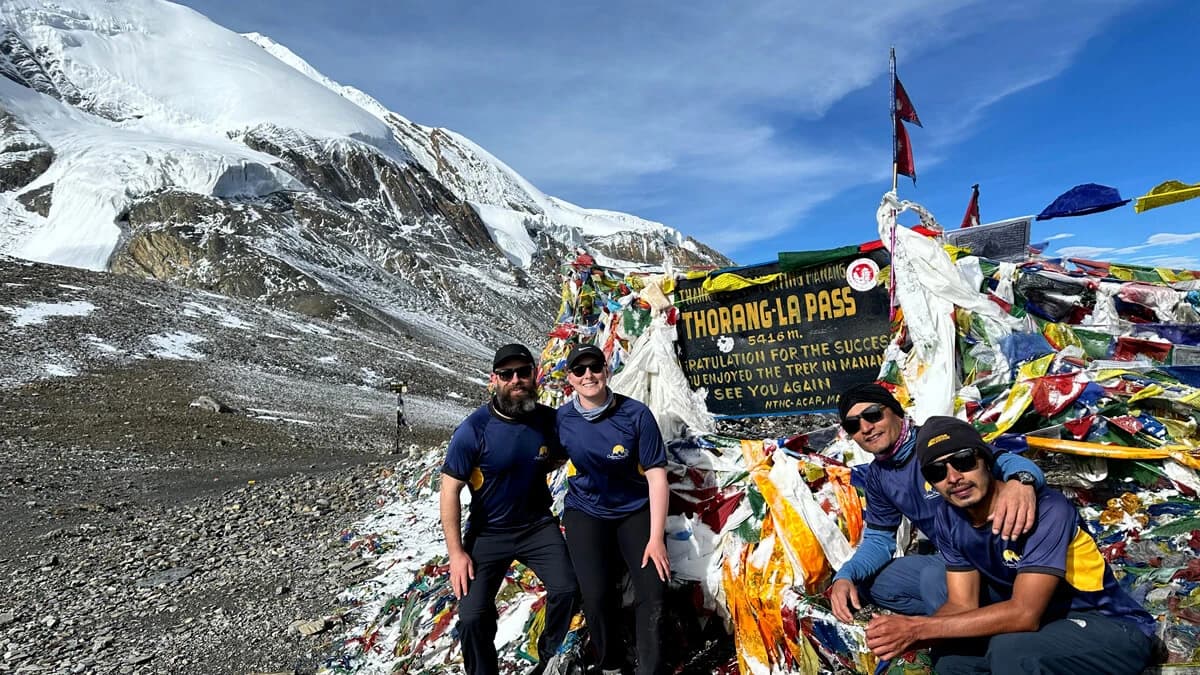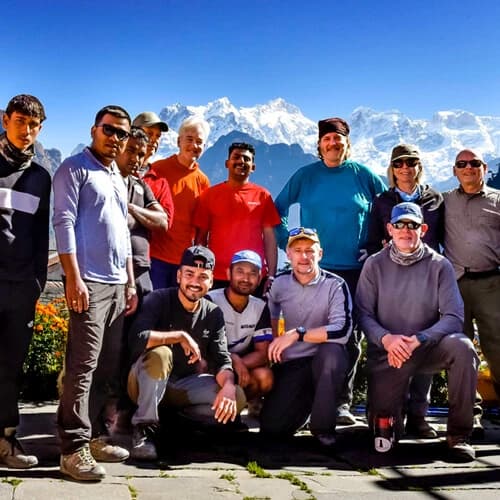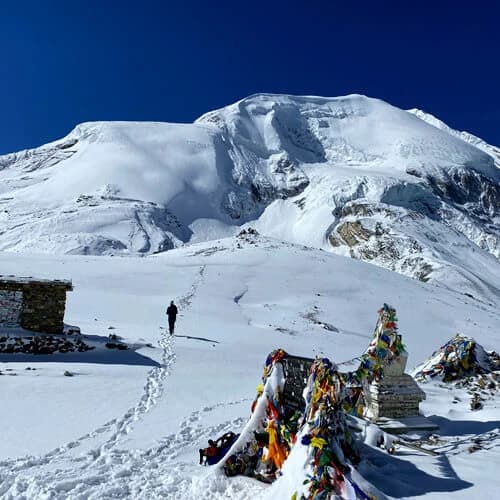How challenging is the Annapurna Circuit trek?
The Annapurna Circuit is a moderate to challenging trek recommended for physically fit trekkers who have gained prior experience. The altitude gain in this journey is significantly high, causing medical issues such as altitude sickness. Thus, travelers have to walk at a gradual pace and acclimatize adequately to avoid the illness. During this expedition, you will walk for 6 to 8 hours, covering a distance of 8 to 15 km daily for 15 to 20 days, depending on the itinerary. Travelers with no prior trek experience might over-exhaust their bodies, so we recommend it for individuals who have completed high-altitude trekking. Further, the unpredictable weather conditions will cause further challenges. You might face rain or snowfall if the region's climate changes drastically. So, properly gear yourself to tackle these challenges and have an enjoyable trek experience.
Factors determining the Annapurna Circuit Trek difficulty
Before you make up your mind, it is essential to understand that the difficulty level of the Annapurna Circuit Trek is multifaceted. This means that the challenges one might face are determined by several factors. These include prior experience, physical fitness, adaptability, duration, terrain, etc. In this section, we will break down these aspects and their effects on your experience of the Annapurna Circuit.
Prior experience
Previous experiences in high-altitude trekking are highly valuable for a successful Annapurna Circuit Trek. As the trail encompasses diverse landscapes, altitude gain, and unpredictable weather, it is recommended for participants to engage themselves in short hikes and treks. Doing so can stimulate the conditions you might be facing in the Annapurna Circuit. This experience also helps you evaluate if you are ready to take on new challenges or need further preparations. So, it is recommended that travelers have prior experience in high-altitude trekking as they are accustomed to long, exhausting hikes and adapting to altitude sickness. Being familiar with basic first aid, navigation, and dealing with unexpected situations is also helpful.
Lack of Physical Preparation
Poor preparation for the Annapurna Circuit trek leads to several challenges, including injury, illness, and tiredness. If you are someone who has not trained for the trek, you will experience immense exhaustion and fatigue on the trail. Additionally, as this tour demands proper rest, your body might recover slowly from the hike and disrupt the acclimatization process. This can cause participants to suffer from headaches, nausea, and insomnia. So, a good fitness and endurance level is essential, and travelers must train 3 months before the scheduled time. Besides, the lack of proper knowledge regarding the gears and equipment will also cause more physical challenges. For instance, inadequate gear and missing essential gear such as knee and back support will further strain your body. We suggest you contact us if you need any guidance regarding the gear and clothing for the Annapurna Circuit.
Pre-existing Medical Conditions
Health and medication on the Annapurna Circuit are very important factors for a successful trek. You must not ignore any health complications and must evaluate your health with a professional. This will enable the proper assessment to decide if you are prepared for the hike in high-altitude regions. As this trek goes above 3,000m, any unchecked previous conditions you might have could affect your overall health. So, every Annapurna Circuit trek participant needs to get themselves thoroughly checked before deciding to begin this journey. In the trail, you can trust us for your safety and well-being. Our staff members are well-equipped with essential medications to cure common illnesses, including headache, fever, diarrhea, and altitude sickness. Further, our guides are equipped with a first-aid kit, which will be helpful if you suffer from minor cuts and injuries. For severe conditions, we utilize the oximeter to check your pulse rate and oxygen levels and provide you with oxygen canisters to ease your exhaustion.
Risk of Altitude Sickness
The Annapurna Circuit Trek exposes trekkers to considerable variations in altitude, from as low as 800 meters up to a maximum of 5,416m at Thorong La Pass. Travelers without prior experience will likely experience early signs of altitude sickness at 2,500m. The early symptoms of the illness include:
- Dizziness/Lightheadedness
- Nausea/Vomit
- Insomnia
- Tiredness
- Rapid heartbeat
- Shortness of breath
These symptoms can worsen over time if ignored. We suggest you listen to your body and report it to our guides if you feel unwell about yourself. Here are some methods you can practice to ease the illness and stop its progress.
- Stay hydrated
- Avoid alcohol and tobacco
- Consume foods that are high in carbohydrate
- Do not rush and walk in a gradual pace
- Drink natural remedies like ginger tea and garlic soup
- Get adequate rest
Long Distance Hiking trails
The Annapurna Circuit Trek covers a distance of about 160-230 kilometers (100-145 miles), depending on the route and itinerary. It usually takes 15-20 days to complete, with daily walking times ranging from 5 to 8 hours. An average person with no experience in long-distance trekking in high altitudes will find it challenging. Travelers with low fitness levels and endurance might also over-exhaust their bodies, leading to injuries such as muscle sprain. Moreover, the trail traverses through steep ascent and descends on varied landscapes. As a result, a novice trekker might have difficulties navigating the terrain without proper guidance. Thus, evaluating yourself before beginning your adventure in the Annapurna region is essential. One must develop experience in hiking and trekking before kicking off the trail in the Annapurna Circuit.
Coming across varied terrain
The diverse terrain and landscape encountered on the Annapurna Circuit contribute to the challenging nature of the trek. In the lower parts, the trail goes through subtropical rhododendron, oak, and bamboo forests, with relatively easy trails. The route passes through deep valleys containing rocky and rugged landscapes as the trail ascends. Higher up, the path you will be walking on traverses on loose gravel. Hiking through these parts is tricky as one might lose footing and severely injure themselves. As you approach Thorong La Pass, you will walk through alpine meadows with expansive views of the Annapurna range. The landscape from here then changes to a high-altitude desert with dry, barren, rocky terrain and minimal vegetation. Overall, this trek's ever-changing topography imposes challenges, requiring travelers to navigate while preparing to enjoy the rewarding experience.
The weather is unpredictable.
The weather pattern in the Annapurna region is volatile, and although it can be predicted by seasonal patterns, it can change drastically at any time. These circumstances are more likely to happen during winter and monsoon season. The sudden downpour of rain or snowfall will cause challenges during the course of the trek. In such conditions, the trails get slippery as they become wet with rain and snow. Moreover, the atmosphere is clouded with fog and mist, obstructing the mountain ranges' visibility and views. In terms of temperature, it can fluctuate rapidly, ranging from 10°C to 25°C during the day and - 10°C at night. We advise travelers to begin the trek during spring and autumn to avoid the challenges caused by unpredictable weather and temperature fluctuations. These two seasons offer optimal conditions to travel, such as clear skies, dry trails, dense vegetation, and longer daytime.
Basic amenities in accommodation
Although the accommodations do not directly impact the trek's difficulty, they play a significant role in the overall experience as they ensure comfort and rest. The accommodation options on the trail include teahouses, guesthouses, and lodges. While some of them feature top-notch facilities and amenities, the ones at higher elevations are fundamental. Thus, in such circumstances, travelers must make practical preparations to adapt. Besides, In peak trekking periods, these lodges can get fully booked, obliging trekkers to consider flexibility in their plans. So, early accommodation booking is an integral part of planning the trek.
Dietary Preferences
Your personal dietary preferences might make the trek challenging as food options become more limited at higher altitudes. As one must consume high amounts of proteins and carbohydrates to re-energize their body, the lack of options for food will impact the trek experience. Moreover, cultural differences and the convention of local food make it impossible to observe several dietary requests, especially in areas far from large cities. Most tea houses usually offer a small selection of regional dishes and fusion food, but these options decrease as you ascend higher. The limited meals and ingredients in remote areas of the journey might affect travelers with specific dietary needs, such as vegans, gluten-free, or lactose intolerance. Regardless, the issue can be solved with thoughtful preparation and arrangement. You can specify your dietary needs before the trek, allowing us to manage the meals at the tea houses as per your requirements.
Is Annapurna Circuit Trek suitable for me?
If you are a beginner in trekking, you might face more challenges than an experienced trekker. The physical fitness for a participant beginning this trek must be in good physical condition and endurance. We do not recommend this expedition for travelers who do not fit these basic requirements. Besides, although there is no age limit, the trek is suitable for the age group of 10 to 70 years old who are experienced in high-altitude trekking. Having said that, it is also important to note that people with physical disabilities cannot physically complete the circuit. Regardless, participants using these criteria can still cover most parts of the circuit via jeep. It allows them to experience travel in a short amount of time.
Note: If you are unsure if the trek is suitable for you, please reach out to us so we can evaluate you. This allows you to guide and recommend a similar trek in Nepal that is more fitting for your interests and experience.
How to prepare for the Annapurna circuit trek?
Preparing for the trek requires a comprehensive approach that targets enhancing fitness, mental endurance, and overall health. Follow the basic guidelines below to start your training for the adventure ahead.
- Physical: Begin your preparation at least three months before and indulge in a strict workout regime. Focus on building your strength and stamina by jogging, cycling, squatting, swimming, and weight-lifting exercises.
- Mental endurance: To stay motivated, you must set realistic expectations and goals. Practice yoga and mindfulness to stay calm while facing the challenges on the trail.
- Healthy diet: To remain fit, we suggest you consume lean proteins, carbohydrates, green vegetables, and healthy fats to fuel your training.
Gears and essentials for the Annapurna Circuit Trek
Packing the right gear and clothing is an important step every traveler must abide by for a safe and successful trek. The following is an essential list of items you must pack for the adventure. Please take this as a starting point, and contact us if you need further guidance.
- Clothing: Thermal tops and bottoms, Fleece jackets, down jackets, Waterproof/Windproof jackets and pants, Trekking shirts and pants(Lightweight/Quick-drying/Breathable), undergarments, Insulated warm hat and gloves, Buff and scarf.
- Footwear: Trekking boots(Sturdy/Waterproof), Trekking socks(Sturdy/Waterproof), gaiters, slippers, and training shoes.
- Backpacks: Day pack(15-30 litres) with hydration bladder, Waterproof Duffel bag( 85-100 liter), Sleeping bag(-18 to -6°C).
- Equipment: Trekking Poles, Headlamp, Knee support, Back support, Sunglasses, Camera, Batteries, Power bank, Portable charger, Travel pillow.
- Medication and personal items: First-aid kit, Personal medications, Sunscreen, Moisturizer, Insect repellant, Water purification tablets, Toiletries, Towels, Sanitizers, Toilet roll, Wet wipes.
Practical tips for making your trek easier
- Take rest days at key points, especially above 3,000 meters, to allow your body to adjust to higher altitudes and reduce the risk of altitude sickness.
- Carry only the essentials. To reduce strain, focus on lightweight, high-quality gear like a compact sleeping bag, lightweight clothing, and a small, comfortable backpack.
- Drink plenty of water throughout the trek to avoid dehydration, especially at high altitudes. To ensure the water is safe, use water purification tablets or a filter.
- Fuel your body with hearty, nutritious meals like dal bhat, and take regular breaks to prevent fatigue. Adequate rest each day will help you maintain energy levels.
- Trekking poles stabilize and reduce knee strain, especially on steep climbs and descents.
- Pack for variable weather conditions, with layers to stay warm in cold temperatures and light rain gear for sudden showers.
How to obtain a Nepal Visa?
For a smooth procedure, you can apply for the visa online months before your arrival. Alternatively, travelers can receive it upon arrival at the Tribhuvan International Airport in Nepal.
Is Travel Insurance necessary?
Comprehensive travel insurance is mandatory for participants beginning their high-altitude trekking in Nepal. It will ensure coverage for loss, theft, medical bills, flight delay/cancellation, and emergency evacuation above 5,000m.
How to book the Annapurna Circuit Trek?
To reserve this package, you must deposit 10% of the total cost. You can make the payment online via mobile banking, bank transfer, or credit or debit card.
What Permits are needed for the Annapurna Circuit Trek?
To trek the Annapurna Circuit, you will need two main permits: the TIMS Card (Trekkers' Information Management System) and the ACAP Permit (Annapurna Conservation Area Permit).
Is having a guide or porter necessary when trekking the Annapurna Circuit?
It is highly recommended that travelers hire and utilize the services of a guide and porter. They will not only assist you with the trek but also ensure your safety and well-being.
Some Most Popular Treks




